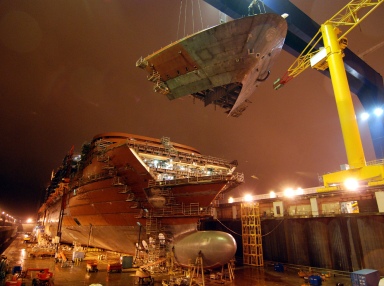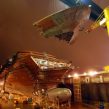
“Wind from the West” Brings a Storm to Russian Shipyards
Publication: Eurasia Daily Monitor Volume: 6 Issue: 208
By:

“The Wind is coming from the west up the Gulf of Finland.” Those who have read Alexander Pushkin’s Mednyi Sadnik (The Bronze Horseman) know that such winds bring with them long waves into the Gulf of Finland and powerful storms that flood St. Petersburg. In this case, the wind is a vessel, the French amphibious assault ship, Mistral, which will visit Peter’s city on November 23, according to a spokesman in Russia’s Baltic Fleet. Paris and Moscow have opened official negotiations on the Russian purchase of one Mistral-class helicopter-carrying amphibious assault ship. This vessel, will be built under the economic stimulus strategy adopted by Nicolas Sarkozy’s government at the STX shipyard in St. Nazarre, France, in partnership with the French shipbuilder DCNS (like the third Mistral-class ship now under construction). STX, one of the most advanced shipyards for building cruise ships, will bring advanced civilian technology to the project to reduce construction costs. Moscow plans to purchase one such vessel and then secure a license to build three others in Russian shipyards (RIA Novosti, November 5).
For France, the sale of the Mistral means added work to French shipyards and future profits from the licensed construction of follow-on ships in Russia. For the Russian government, it will mean the acquisition of a class of ship not presently in the Russian navy and access to innovative technologies developed by civilian ship-building now applicable to warship construction. The visit will also bring more storms of protest from Russian naval shipyards that will see much needed capital going abroad rather than into domestic construction (RIA Novosti, November 5). For an industry that had a near monopoly on all naval construction in the Soviet Union and faced hard time times after the fall of the Soviet Union, this is a bitter pill in terms of economic loss and the assault on national pride.
Critics question the rationale underlying the procurement and claim that the Mistral-class ships are not required. The arguments divide into two camps: those questioning the specific purchase of this ship for power projection missions, and those opposing naval acquisitions and questioning the Russian navy’s ability to maintain a major warship of foreign or domestic construction. In an interview in Komsomolskaya Pravda, Mikhail Barabanov, an analyst at the Center for Analysis of Strategies and Technologies (CAST) and a strong supporter of Russian domestic shipbuilding, characterized the Mistral as a “white elephant” and summarized his argument against the purchase in the following terms:
“From the standpoint of operating a single ship in the navy, radically different from domestic standards, will be nothing more than a typical “white elephant” of dubious military value. Discussion on the construction of three more Mistral ships when the navy cannot even finance the construction of corvettes, turning them into protracted procurements, just looks like a bad joke. The reduction of surface combat ships and vessels in the Russian navy is at a pace that it is not clear what ships of the fleet will protect and provide air cover for the Mistral at the time of its commissioning. Finally, it is striking that the leadership of the navy has not found sufficient funds for the domestic shipbuilding industry, already choking because of scarce public funding, but is ready to so easily dump half a billion Euros for the maintenance of the shipbuilding industry in a NATO country. Yes, even in conditions of economic crisis and rising unemployment” (Komsomolskaya Pravda, September 21).
Barabanov was addressing the age old question confronting advocates of Russian sea power: “does Russia need a navy?” If so, then it must have its own shipyards and works because as a continental power with limited maritime access, it cannot depend upon ships and technology from abroad in time of war. Barabanov is a very strong supporter of Russian naval exports, which have kept the St. Petersburg and Severodvinsk yards in operation during two decades of economic crisis. Equally, he advocates what was the Cold War model of exclusive domestic naval construction in the socialist camp. However, in the information age this resulted in Russian warships facing serious limitations in Command, Control, Communications, Computers, Intelligence, Surveillance and Reconnaissance (C4ISR) and electronic warfare. Events in the South Caucasus last year revealed serious shortcomings in these areas, and the ministry of defense and the General Staff seem committed to addressing these weaknesses (Nezavisimoye Voyennoye Obozreniye, January 23).
Moreover, the decision to purchase the Mistral highlights a traditional answer to Russia’s problem in maintaining the competitive edge of its own naval shipbuilding industry. Autarky means isolation from global innovations in the various technologies that support systems involved in both naval and commercial shipbuilding. It is a problem that Russia has faced since the beginning of the industrial revolution, and the information age makes this challenge even more pressing.
In a recent article on Franco-Russian security cooperation, Natalia Yarmolik cited the personal initiatives of President Sarkozy and Dmitry Medvedev in enhancing the level of bilateral cooperation in search of European security. For Sarkozy, it would seem to be that his first priority is France’s recovery from the current global economic downturn, and the Mistral will mean jobs for French workers. For Medvedev, the importance of Franco-Russian dialogue on security serves as a first step toward a new security structure in Europe, which would stress common interests and exclude Russia’s isolation (Krasnaya Zvezda, October 2).
Russia’s naval leadership has frequently sought foreign technology to upgrade its domestic shipbuilding, which involved buying a prototype of a particular class of warship abroad and then developing the capacity to build the same class in Russia and to apply foreign innovations to future domestic designs of other classes. This was so in tsarist Russia and in the Soviet Union before the Cold War. The strongest proponents of exploiting expertise in foreign shipyards came from Russia’s leading sailors, who were aware of foreign developments and found state shipyards slow to build ships and even slower in innovations. One suspects that the current leadership of the Russian navy is trying to build a fire under its own domestic shipbuilding industry by imposing external competition upon it. It also appears that the Kremlin is gambling that the wind from the west will bring fair skies after the initial storm at home.




